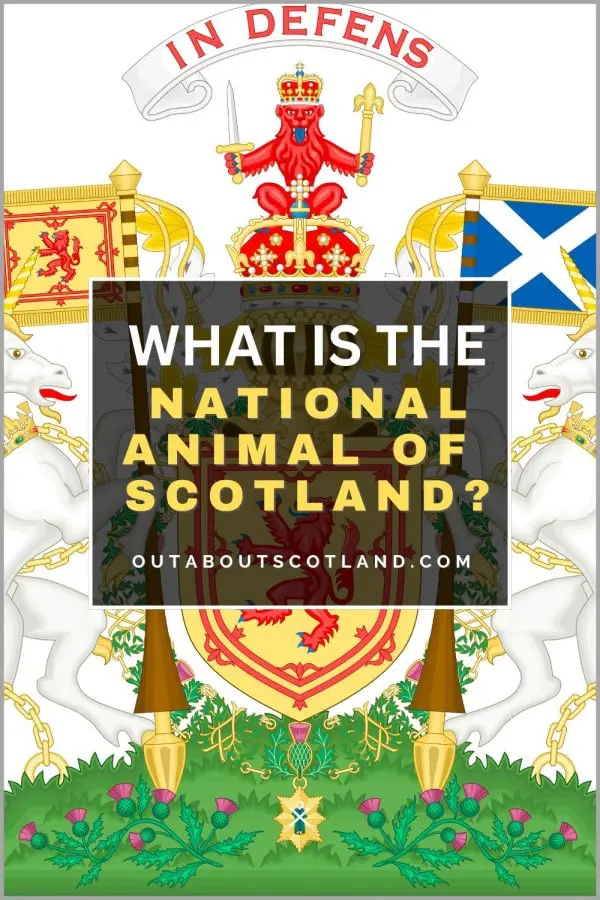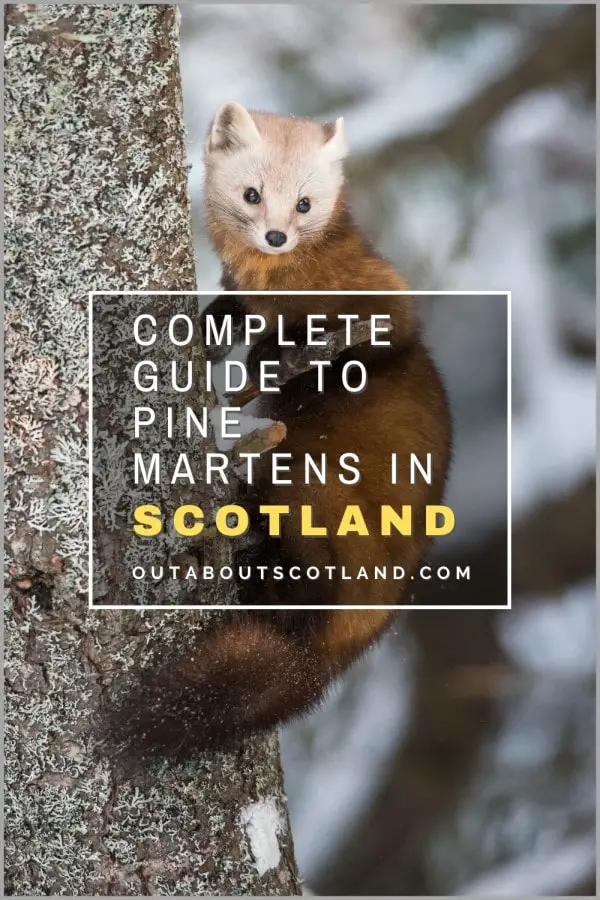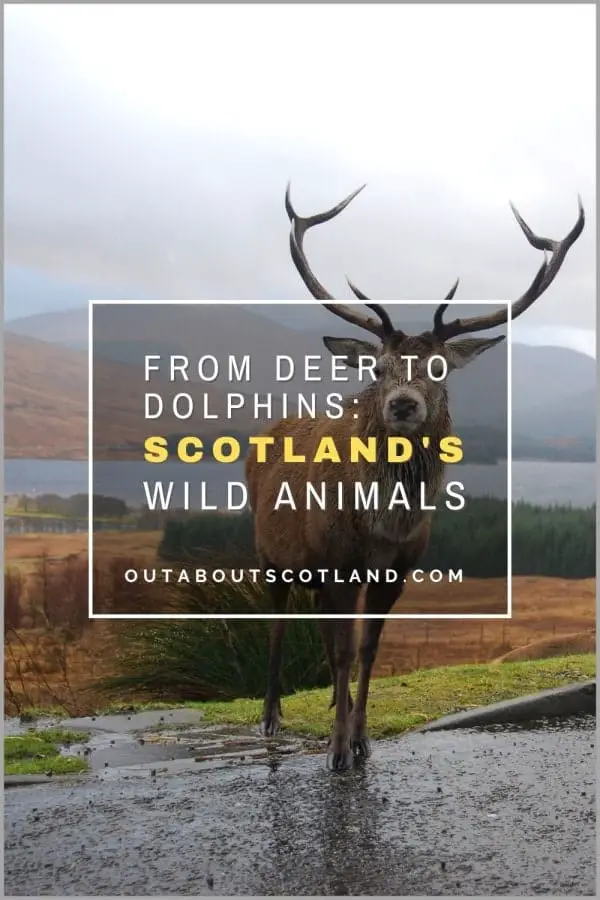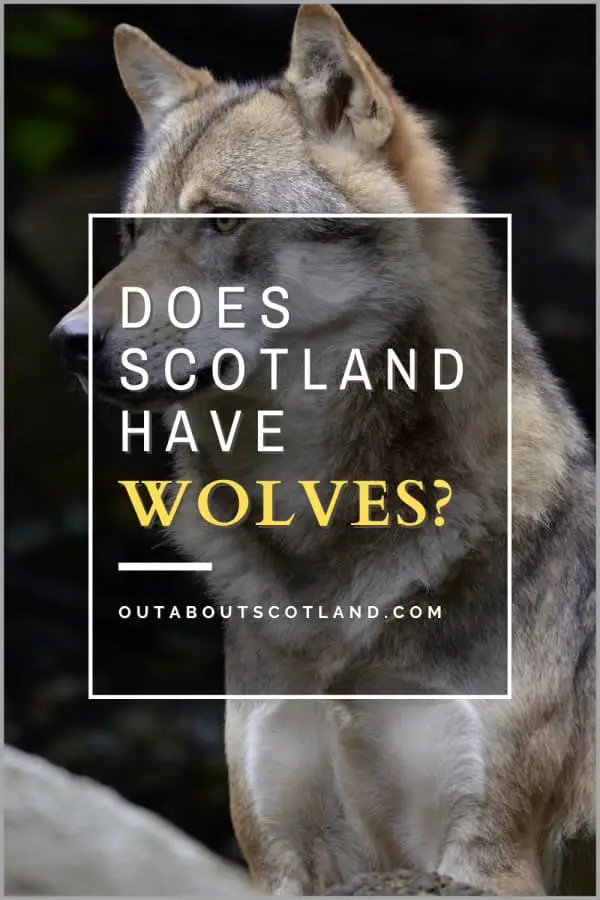Highland cows are a Scottish breed of rustic cattle known for their thick, shaggy coats that enable them to survive in the harshest of temperatures. You’ll find them throughout Scotland in places like the Cairngorms, the Isle of Mull, Galloway Forest Park, and many other places. Discover exactly where you can see Highland cows in Scotland in this guide, which includes a heap of fun facts about these famously hairy animals.

Where to See Highland Cows in Scotland
Because they’re such an iconic Scottish animal you might think you won’t be able to move for the enormous roaming herds that fill every available green space in Scotland. The reality, however, is that sightings of them are quite sporadic and there’s every possibility you’ll spend an entire holiday in Scotland and not see a single one, especially if you stick to the cities.
If you’re desperate to see them, the most obvious place to look is the Highlands (well, duh…), but there are several other areas where you’ll have a good chance to get your Instagram snaps. One of these is Aberdeenshire, which is one of the biggest farming regions in Britain, and you’ll frequently see Highland cows in the county’s fields, but it’s better known for the Aberdeen Angus cow, which is a short-haired black-coloured beast that’s very stocky and as far removed from Highland cows as it gets.
Another place to look is the Cairngorms National Park, which has lots of animals grazing freely, but there are also a few places in the southwest of Scotland as well as some of the inhabited west coast islands to see them.
Elsewhere you’re likely to see Highland cows in any of Scotland’s petting zoos like the Heads of Ayr Farm Park or Jacksons at Jedburgh as well as a few Highland cows near Loch Lomond and at Culloden Battlefield. There are even farms that offer bespoke ‘cow safaris’ like Airyollan Farm in Southwest Scotland.
Protect Your Family From Scotland's Biting Midges
- Powerful, reliable protection for up to 8 hours
- Water- and sweat resistant
- Repels midges, mosquitoes, horse flies, sand flies, fleas and ticks
- Safe for use on adults, children over 30 months and pregnant women
- Non-sticky, moisturising with a pleasant fragrance
- Packaging may vary
The Highlands
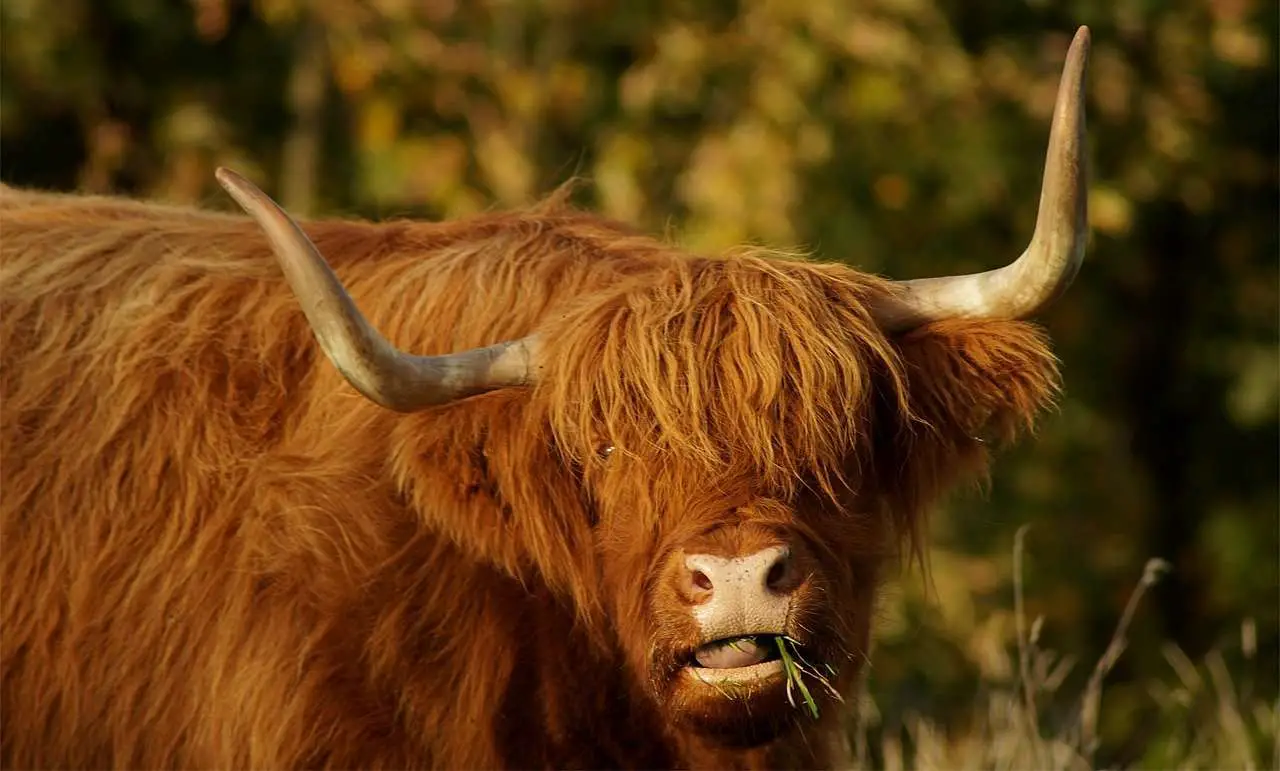
Sutherland is a county in the far north of Scotland that is a popular place to visit not only for the stunning coastline that can be seen on a tour of the NC500 but also for the Highland cows that can often be seen lazing around on the warm sand at Clachtoll and Achmelvich beaches.
The Highland Folk Museum is a museum and open-air visitor attraction in Newtonmore in Badenoch and Strathspey in the Scottish Highlands which aims to preserve the memory of the traditional Highland way of life. One section – Aultarie Croft – has a few very sociable heilan coos that are used to being petted by visitors.
Torridon is a small village in the northwest Highlands that’s a popular tourist destination due to the fact it’s set in one of the most stunning landscapes in Scotland. The open expanses of moorland act as the perfect grazing site for Highland cows.
Plockton is a small village that faces Loch Carron near Skye and it’s a bit of a must-visit if you want to take a step back in time. Highland cows are allowed to walk around the village quite freely which is the perfect setting for a quick coo selfie.
Applecross is the home of Britain’s highest, most twisty-turny road (the Bealach na Ba) which attracts tourists by the coachload who are keen to see the wonderful coastline in that remote corner of Scotland. It’s also prime coo-watching territory.
Northeast Scotland
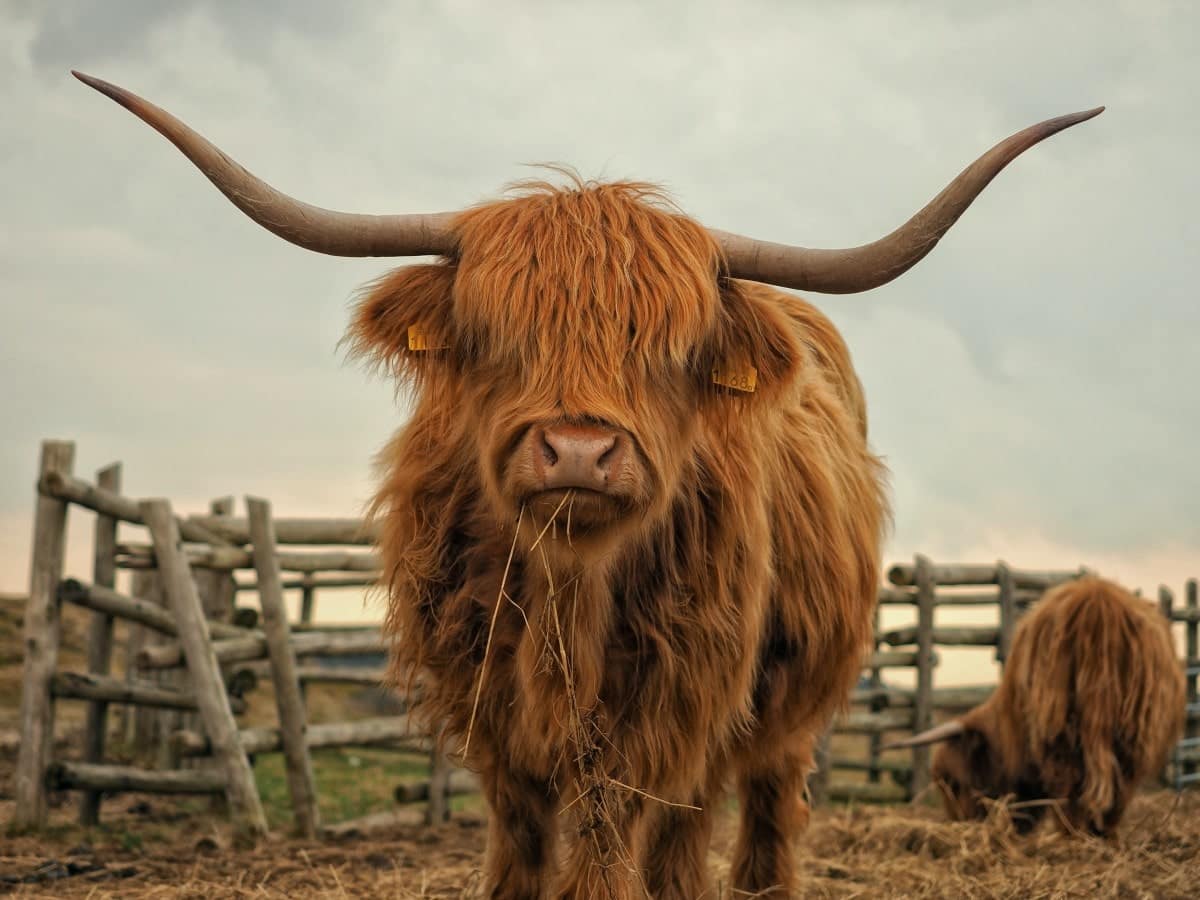
The historic town of Banchory in Royal Deeside is known for two popular historic tourist attractions: Crathes Castle and Drum Castle. This is a lovely part of the country that’s not inundated with crowds of tourists, so saying hello to the Highland cows near the Crathes Castle entrance is highly recommended.
Meldrum House Hotel is close to Banchory and the Glen Garioch whisky distillery on the A947, around a 30-minute drive northwest of Aberdeen. The hotel is notable for having a fold of cows on the grounds.
If you love Scotch whisky you’ll love a visit to the Macallan distillery as it has one of the best visitor centres in Scotland. Located in a gorgeous countryside setting, the grounds are home to the distillery’s very own collection of Highland cows. Seeing them is also a good excuse to pick up a bottle of single malt.
Book Tours in Scotland
Southwest Scotland
Pollok Country Park in Glasgow is criminally under-visited by international visitors, in my opinion, as it’s a beautiful park that’s an easy drive from the city centre. The 146-hectare park has lots of attractions, including, you guessed it, Highland cows.
Galloway Forest Park in Dumfries and Galloway is the perfect place to switch off from busy city life and enjoy nature. This is the largest forest park in the UK, and it’s famed for its walking and cycling paths as well as its Highland cattle that graze freely inside the forest boundaries.
Hirsel Country Park only just makes it into this list because it’s right on the border with England, but I had to include it as it’s the location of the magnificent Hirsel country house and the estate has its very own fold of coos.
Southeast Scotland (Edinburgh)
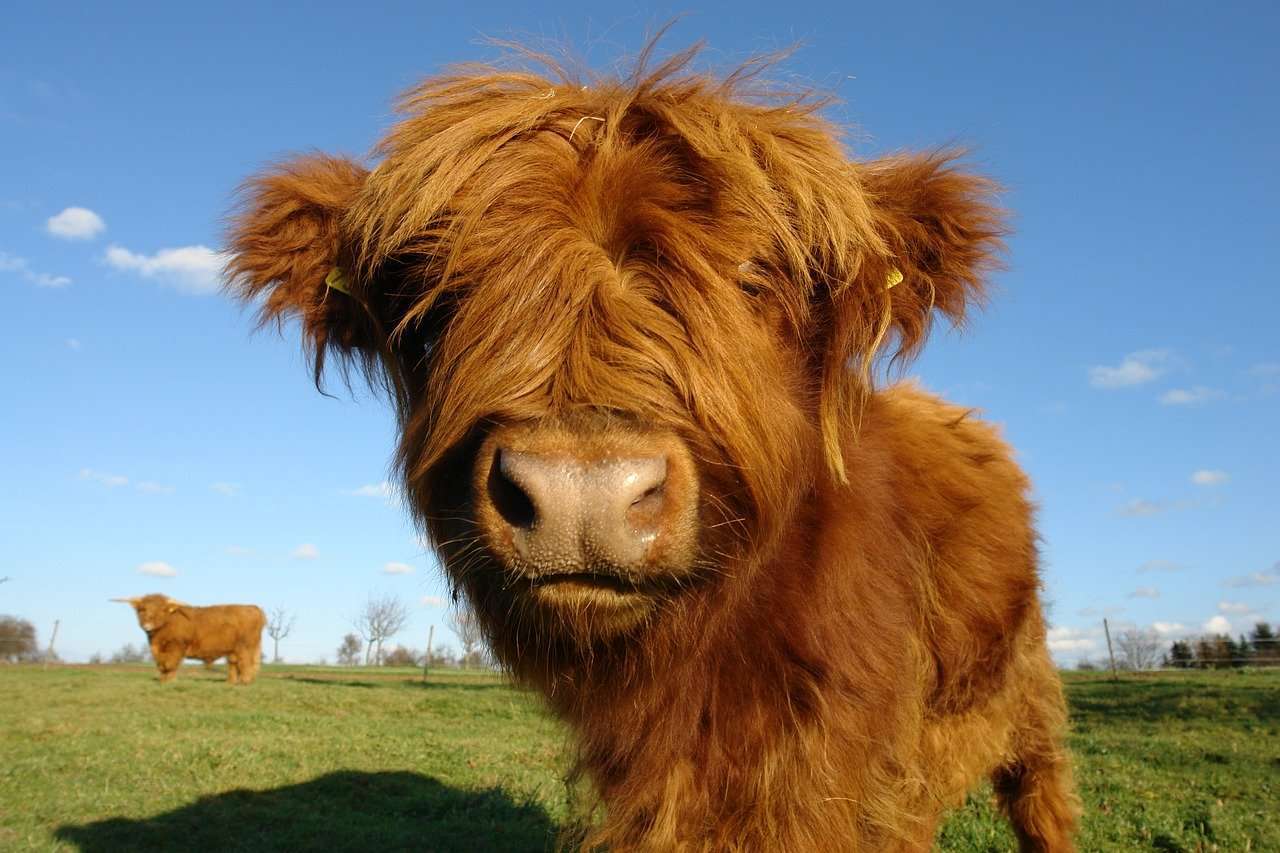
If you’re wondering where to see Highland cows in Edinburgh I recommend driving to Prestonfield House which is home to a few Highland cows that live in the 20 acres of gardens that surround the main building. This is one of the most luxurious places in Edinburgh, as it’s the location of one of the poshest hotels in the city, but they also welcome visitors to stop by for a drink or a meal on the terrace, after which you can explore the gardens in search of their fold of cows.
Swanston Farm is located just outside the city bypass where it borders the gorgeous Pentland Hills, so visiting the farm is an ideal opportunity to go for an enjoyable walk afterwards.
This isn’t a typical farm because the area that’s open to the public is set up as a countryside retreat, although there are over 300 acres that can be walked around to the immediate north of the Swanston golf club where you might see their fold of Highland cattle.
Mortonhall Caravan Park lies south of the Mortonhall Golf Club and north of the city bypass which means it’s possible to visit it within a 20-minute drive of Edinburgh city centre. Several walking paths run through the site but their Highland cows are usually found near the park entrance.
Protect Your Family From Scotland's Biting Midges
- Powerful, reliable protection for up to 8 hours
- Water- and sweat resistant
- Repels midges, mosquitoes, horse flies, sand flies, fleas and ticks
- Safe for use on adults, children over 30 months and pregnant women
- Non-sticky, moisturising with a pleasant fragrance
- Packaging may vary
The Hebrides
If you’re visiting Scotland you really owe it to yourself to visit the Isle of Skye while you’re here. There are so many attractions on this stunning island it would be impossible to fit them all in this article but in addition to the spectacular natural wonders of the island, you’ll also find Highland cows wandering about – especially near Elgol on the south of the island.
Love whisky? You have to visit the Isle of Islay. This picturesque island has breathtaking scenery, gorgeous beaches and the friendliest people you’re ever likely to meet. It’s a bonus then that it also has lots of Highland cows wandering all over it.
The Isle of Mull comes a close second in my list of best Scottish islands as it’s almost as pretty as Skye but it’s much quieter and just a wee bit cheaper for hotels. Our favourite ginger bovines roam happily around the Glengorm Castle Hotel on the north of the island.
Agricultural Shows
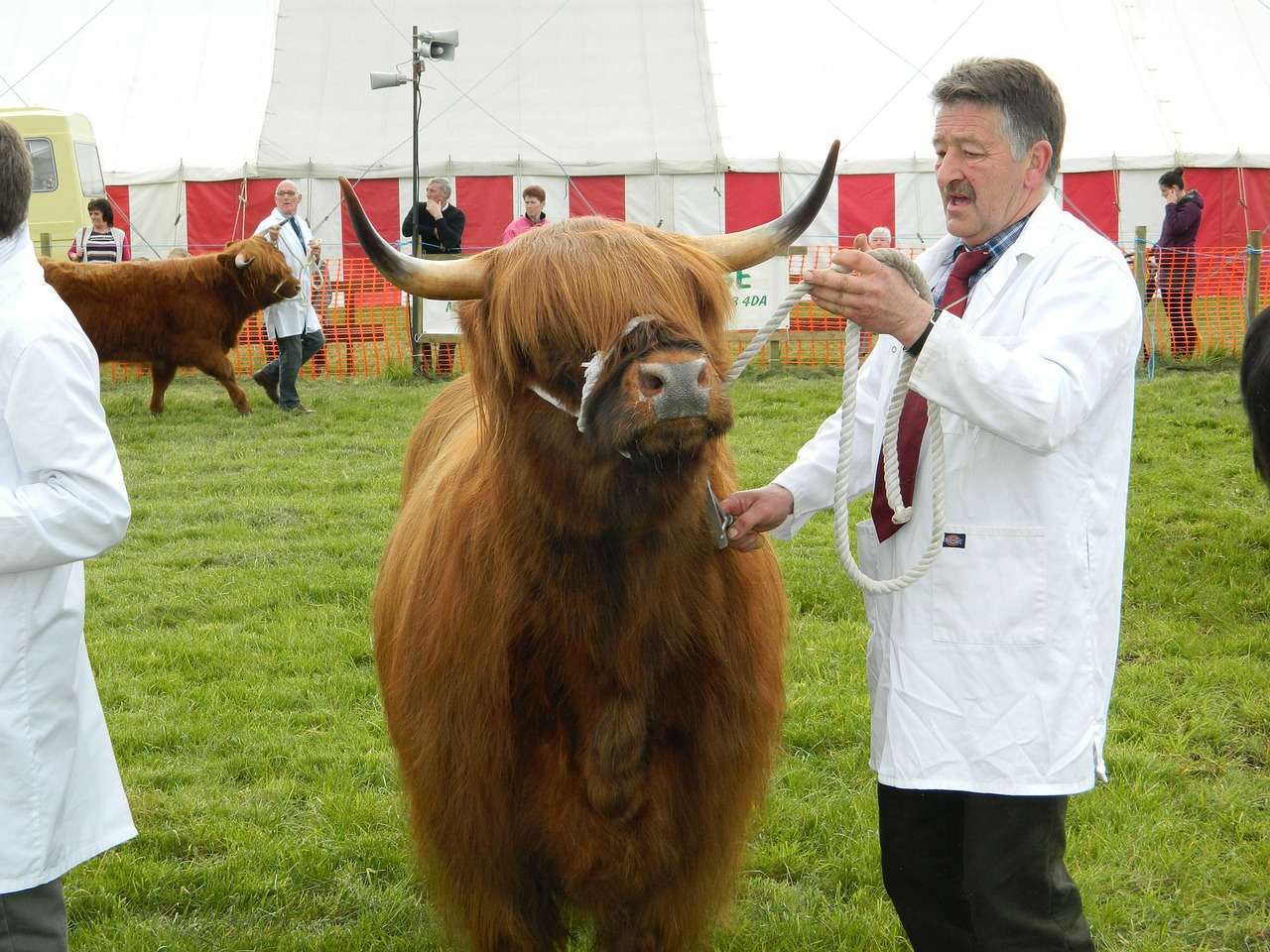
Edinburgh might not be the first place that comes to mind when you think of heilan coos, but head towards the airport in August and you’ll find yourself at the Royal Highland Show, one of the biggest and longest-running agricultural shows in Britain.
The Angus Show held near Dundee is a 2-day event that I’ve previously visited and really enjoyed, hence its inclusion in this list. While it’s not as big as some agricultural shows, it’s very friendly and has a great selection of food stalls as well as lots of interesting farm animal-themed displays.
The Banchory show in Aberdeenshire is even older than the Royal Highland Show having been first staged over two hundred years ago and it’s showing no signs of slowing down with farming displays galore, including many fine specimens of heilan coo.
Book Tours in Scotland
What Are Highland Cows?
Highland cows are a Scottish breed of rustic cattle known for their thick, shaggy coats and an a-moo-singly long fringe covering their eyes that enables them to survive in the harshest of temperatures.
You’ll recognise them instantly as soon as you see their long curved horns and reddish woolly coats, but you might not realise the breed isn’t restricted to one colour. If you visit different parts of Scotland you’ll see several hues of coos from deep red to black, tan, white and grey, but it’s the ginger coats that are most prevalent.
You can thank the Victorians for that as they selectively bred gingers in the late 1800s but apart from the colour, there’s no other discernable difference between cows in the breed.
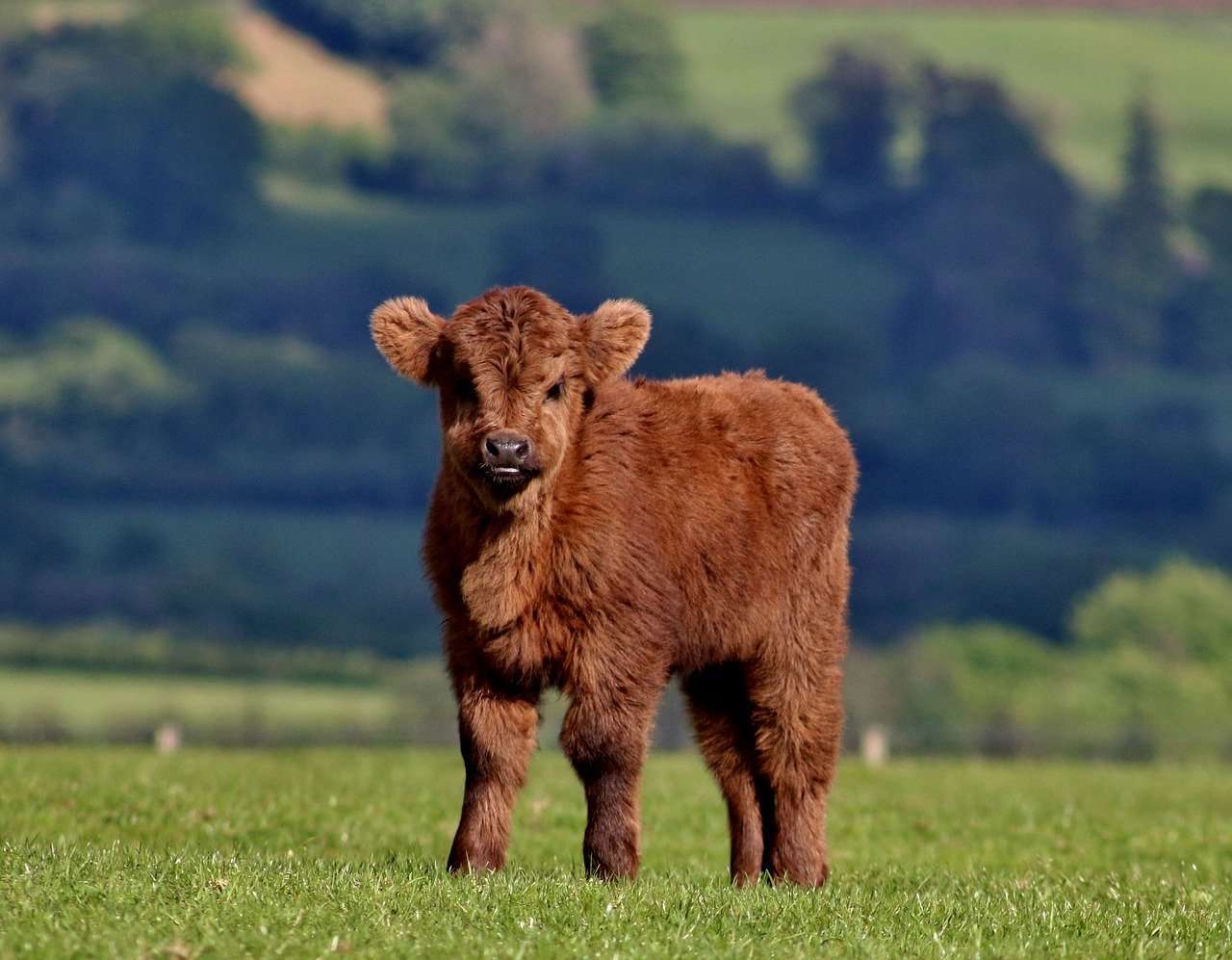
Actually, it was Queen Victoria who was instrumental in the modern ginger colour as she was the one who proclaimed she preferred the look, with Scotland’s gentrified farmers subsequently going out of their way to please her.
There’s more to the straggly coat than the unusual colour though and the reason these cattle are so well suited to the Scottish Highlands is due to there being two distinct layers. First is a soft insulating down that lies close to the body, and second is a thicker outer covering of dense oily hair that protects the skin from Scotland’s frequent downpours.
As far as the origins of the distinctive curved horns go, they evolved from a need to get to the low-lying plants that are covered by a thick layer of snow in the winter months, and the animals are quite effective at clearing great swathes of snow-covered hillsides to get at the juicy plants underneath.
It’s this combination of hardiness and adaptability that makes the Highland cow so well-suited to living in the Scottish Highlands. In Scotland, they’re referred to as Heilan Coos, which is the Scots name for them, but if you really want to impress the locals, try wrapping your tongue around the Scottish Gaelic Bò Ghàidhealach.

Where Do Highland Cows Come From?
The modern Highland cow descended from a much older breed of Hamitic Longhorn that Neolithic farmers brought to Britain about 4,000 years ago. Those descendants of today’s cattle evolved over the following millennia into two distinct breeds: a large type that was common on the Scottish mainland and a smaller type that was bred on the western islands.
The large breed was able to build a sizeable body mass thanks to the amount of rich food they could eat in the (relatively) mild Highlands while the island breed (known as kyloes) stayed relatively small.
From the late 1800s, the mainland and island breeds were crossbred to create the modern Highland cow that we all know and love which is, in fact, the oldest registered cattle breed in the world having been recorded in the registers of the Highland Cattle Society all the way back in 1885. But even more impressively, descriptions of the original Highland and island cows appear in manuscripts dating to the 12th century. No wonder they’re so ingrained in Scottish culture.
Protect Your Family From Scotland's Biting Midges
- Powerful, reliable protection for up to 8 hours
- Water- and sweat resistant
- Repels midges, mosquitoes, horse flies, sand flies, fleas and ticks
- Safe for use on adults, children over 30 months and pregnant women
- Non-sticky, moisturising with a pleasant fragrance
- Packaging may vary
How Big Are Highland Cows?
If you’ve never seen one before, you might at first be a bit intimidated by the size of the things, as they’re pretty imposing, especially with those enormous pointy horns that could do a lot of damage if they get upset. Thankfully, though, they’re very docile animals.
To adhere to the strict guidelines of the Highland Cattle Society, Highland cows must stand between 42 and 48 inches at the hip and they typically have a height at the back of around four feet with bulls coming in half a foot taller. That might not sound much but they’re stocky animals with massive heads that look much bigger in real life than those numbers suggest.
A Highland bull weighs in at an average of 1,700 pounds, while the cows weigh around 1,110 pounds, so you certainly wouldn’t want to get trampled by one – well, not unless it’s one of the show-breed miniatures that are only around three feet tall.
As for their famous curved horns, you might be able to notice that males and females have slightly different types. Bulls tend to have horns that come straight out of their heads at body level with a slight curve upwards at the tips while cows have narrower horns that curve upwards from the base of the head.
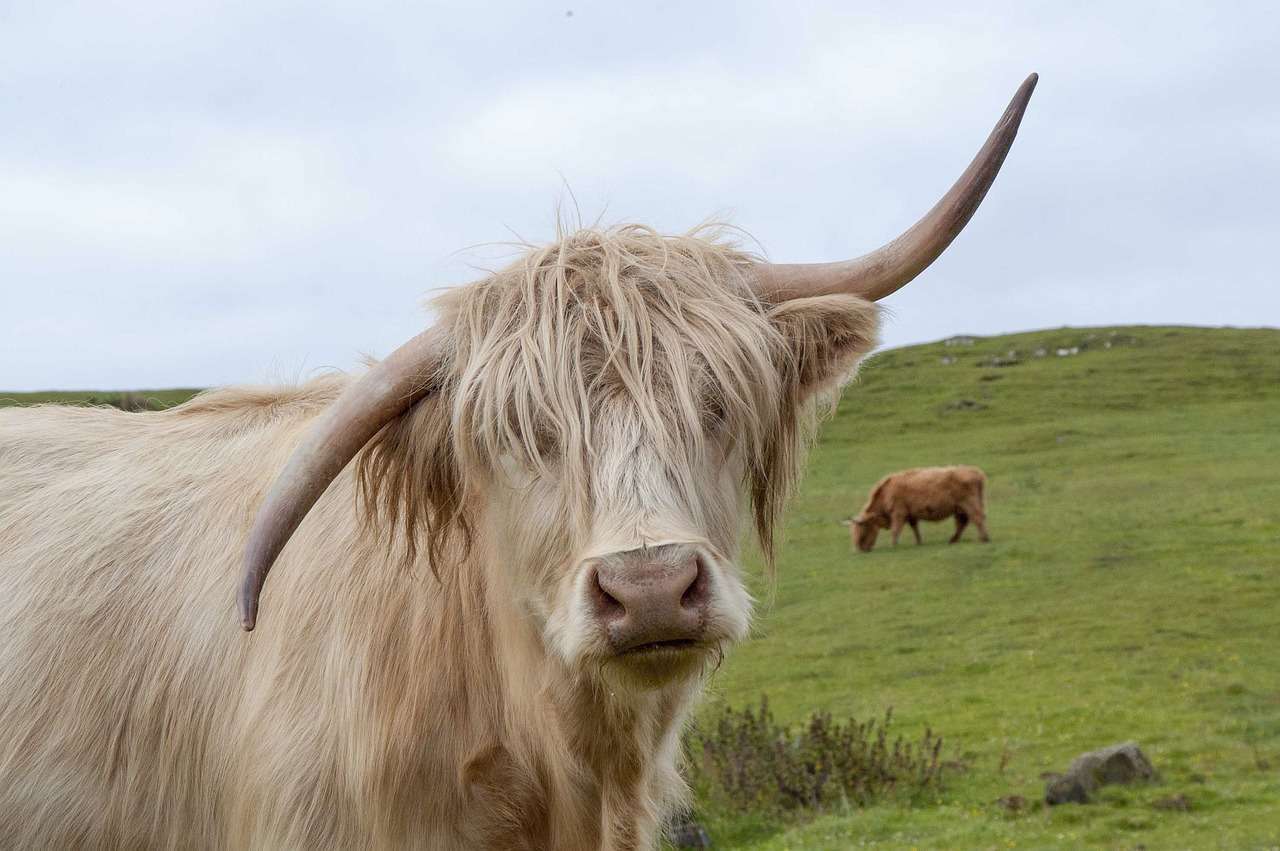
Are Highland Cows Dangerous?
Not unless you get between a mother and her calf. Highland cows have a clear social hierarchy where each one knows its place in the herd so there’s never any in-fighting, although the young bulls will start to show their dominance over the females from around the age of two.
These good-natured creatures are well known for being excellent mothers with a strong bond to their offspring, which is partly due to the fact they have a long gestation period of around 40 weeks. For the majority of the year, the heifers are quite tame, and they’ll often wander over to people either out of interest or actively seeking attention, but that behaviour changes from May to June when the calves are born.
The cows are very, very protective of their young (even before they’ve given birth) and will act aggressively towards humans if they feel their calves are threatened so my advice is to keep a respectful distance if you see youngsters in the field.
This extends to keeping your dogs (and children) on a short leash as Highland cows can quite easily become distressed by sudden movements and loud noises, making them quite unpredictable at times. Not good when combined with big horns and half a ton of body weight.
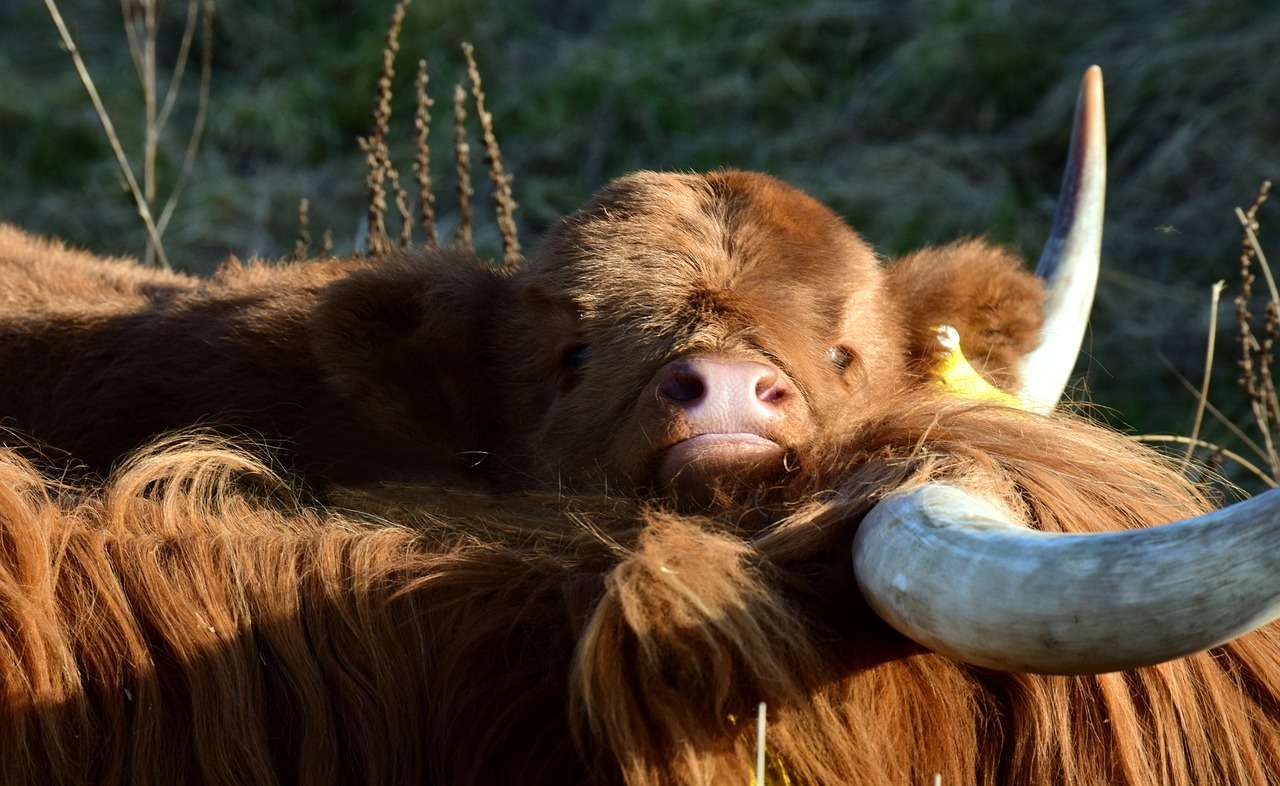
Book Tours in Scotland
Is It OK to Pet and Feed Highland Cows?
Following on from the above question, Highland cows will frequently seek out human interaction and if you walk up to their paddock fences you’ll often see them ambling over for a good scratch. As I mentioned earlier they’re very friendly and good-natured animals so don’t be frightened to say hello, but if they’re showing obvious signs that they don’t want to be touched, i.e. they keep backing away, leave them well alone.
Because these animals are bred to be slaughtered for a profit, Scotland’s farmers will not take kindly to their livestock being harassed by dogs, and in the past, family pets have been shot when not kept under control by their owners.
It’s unlikely that will happen, as the UK law is very strict when it comes to causing any suffering to animals, but if you’re a dog owner who fails to stop your pooch from injuring a farmer’s cattle, you can be prosecuted and become liable for all costs. Basically, keep your dog on a lead at all times around farm animals.
As far as feeding them goes, unless the farmer has specifically installed signs saying not to do it they’ll be more than happy to chow down on a nice juicy clump of fresh grass but please don’t start feeding them junk food as their stomachs aren’t designed to process it.
Farmers feed them hay, green feed, and wheat or corn silage but they won’t turn their noses up at turnips and swede either. They’re very hardy and will eat most vegetation, but try not to feed them any plant material outside of their fenced area as there are several varieties of British wild plants like Pigweed and Dogbane that are poisonous to cattle.
What Are Highland Cows Used For?
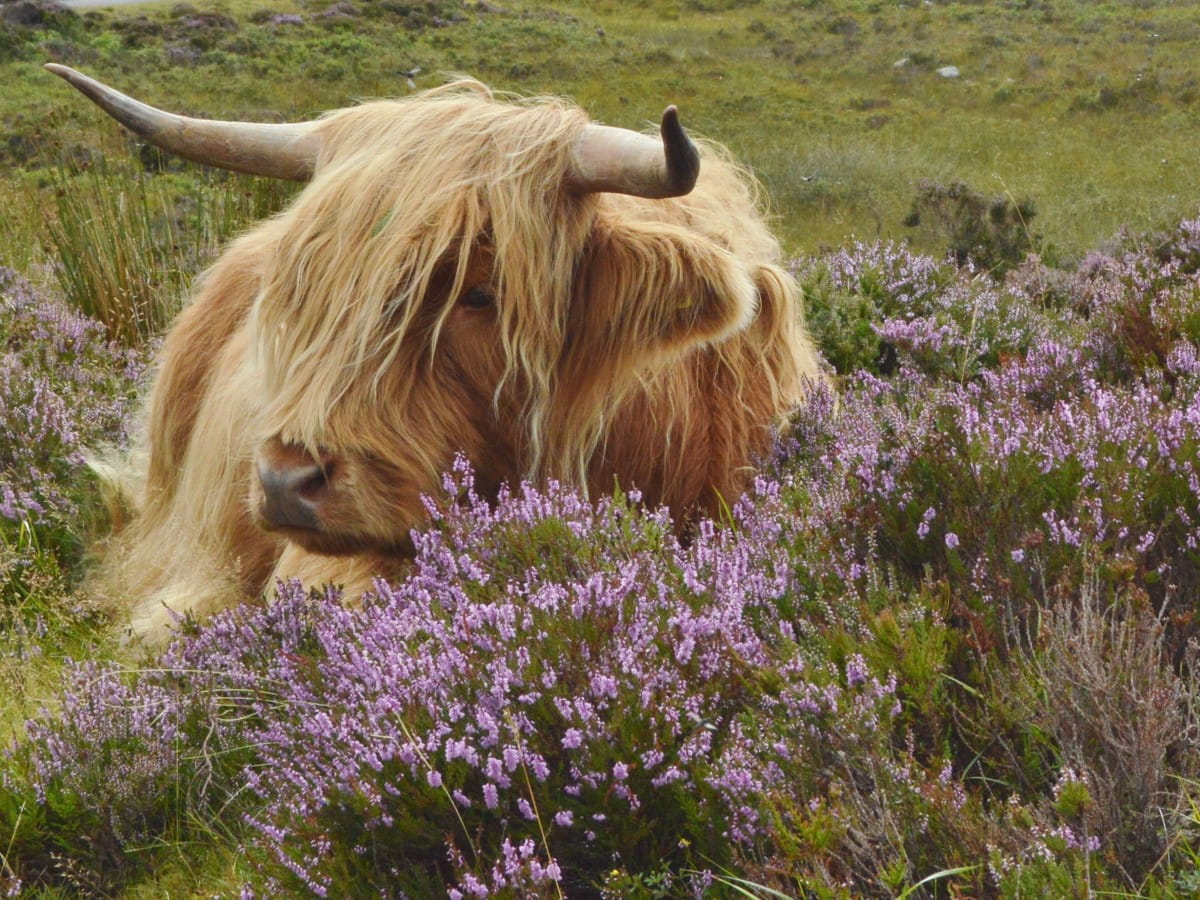
Like most cows in Britain, their sole purpose in life is to provide milk and meat, both of which are top quality.
As they’re slow-growing compared to other breeds, Highland cow meat is fine textured, tender and succulent with a very low cholesterol content. In fact, scientific studies have shown that Highland beef is up to 40% lower in fat than other breeds which makes it extremely valuable to health-conscious countries like the US.
The downside to being slow-growing is that they’re expensive to rear which makes the meat a bit of a luxury in their native land, especially with competing Jersey and British White breeds being kept in far greater numbers in the rest of Britain.
One use for the venerable heilan coo is in cross-breeding where faster-growing breeds of bulls are bred with Highland cow mothers to produce offspring that have the best of both worlds – meat that’s cheaper to rear with a hardiness that allows them to survive in the unrelenting cold of the Highlands.
In addition to making crossbreeds, Highland cows are also kept for their milk which has a high butterfat content, although they’ll never be able to compete with dairy cows like Jersey’s as they only produce an average of two gallons of milk per day compared to a Jersey cow’s six gallons.
The last, unexpected use for Highland cattle is conservation grazing where they eat a variety of unmanaged plants that are unpalatable to other animals. Due to the fact they’re relatively lightweight and quite nimble (for a cow) they’re able to roam across the landscape without causing much damage while keeping unwanted plant life in check.
Protect Your Family From Scotland's Biting Midges
- Powerful, reliable protection for up to 8 hours
- Water- and sweat resistant
- Repels midges, mosquitoes, horse flies, sand flies, fleas and ticks
- Safe for use on adults, children over 30 months and pregnant women
- Non-sticky, moisturising with a pleasant fragrance
- Packaging may vary
Facts About Highland Cows
- Their natural lifespan is around twenty years.
- There are approximately 15,000 Highland cows in the UK.
- Although most cattle in a group are called a herd, a group of Highland cows is called a fold.
- The coat of Highland cattle can grow to thirteen inches long.
- The fringe that covers a heilan coo’s eyes actually has a name – dossan.
- Strong Highland winds can blow debris into their eyes, but their long fringes help to shield them from it.
- Highland cows can produce calves up until they’re twenty years old.
- Females produce an average of 15 calves in their lifetime.
- Calves are quite small for British cattle and weigh less than 70 pounds at birth.
- The Queen has her own fold at Balmoral Castle in Aberdeenshire which is considered to be the finest in the world. They’re rumoured to be the only source of beef she’ll eat.
- Many locals simply refer to them as hairy coos unless it’s calves which are affectionately called fluffy coos.
Frequently Asked Questions
Where can I see Highland cows in Scotland?
You can see Highland cows across most of Scotland but a few favourite cow-spotting areas are:
Highlands – Torridon, Plockton, Applecross. Northeast – Banchory, Aberdeenshire. Southwest – Pollock Country Park, Galloway Forest Park, Hirsel Country Park. Islands – Isle of Mull, Isle of Islay, Isle of Skye.
What are Highland cows?
Highland cows are a Scottish breed of rustic cattle known for their thick, shaggy coats and a long fringe that covers their eyes (called a dossan) that enables them to survive in the harshest of winter temperatures.
They were selectively bred by the Victorians to have a predominantly ginger colour.
Are Highland cows dangerous?
Not unless you get between a mother and her calf, though they are generally docile and good-natured.
The females are very protective of their young and will act aggressively towards humans if they feel their calves are threatened. Also, keep dogs on a leash when walking near Highland cows.
Is it ok to pet and feed Highland cows?
They’re generally friendly animals so don’t be frightened to say hello, but if they’re showing obvious signs that they don’t want to be touched, i.e. they keep backing away from you, leave them well alone.
Farmers feed them hay, green feed, and wheat or corn silage but they also enjoy fresh grass. Some British wild plants like Pigweed and Dogbane are poisonous to cattle.



